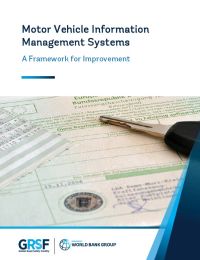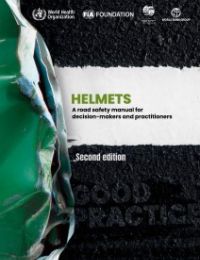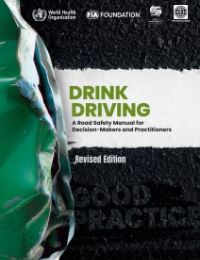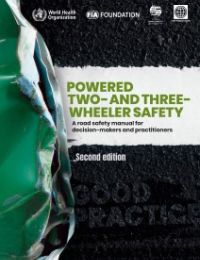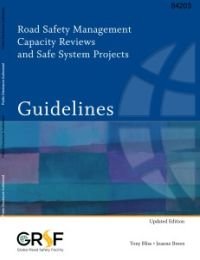Publications
1-9 of 9
-
Road Safety Management
Motor Vehicle Information Management Systems: A Framework for Improvement
March 2025
-
-
Road Users
Drink-Driving: A Road Safety Manual for Decision-Makers and Practitioners (2nd ed.)
November 2022
-
-
Road Safety Management
Road Safety Management Capacity Reviews and Safe System Projects Guidelines
May 2013
-
Specify a management and investment framework to overcome institutional capacity barriers and support the successful implementation of road safety interventions;
-
Provide practical procedures designed for application at a country level to accelerate knowledge transfer and sustainably scale up investment to improve road safety results;
-
Ensure that institutional strengthening initiatives are properly sequenced and adjusted to the absorptive and learning capacity of the country concerned.
-
Road Safety Management
Análisis de la Capacidad en Seguridad Vial y Proyectos de Sistema Seguro (Spanish)
May 2013
- Especificar un marco de gestión e inversión para superar las barreras de capacidad institucional y apoyar la implementación exitosa de intervenciones de seguridad vial;
- Proporcionar procedimientos prácticos diseñados para su aplicación a nivel de país para acelerar la transferencia de conocimientos y aumentar de manera sostenible la inversión para mejorar los resultados de seguridad vial;
- Garantizar que las iniciativas de fortalecimiento institucional estén debidamente secuenciadas y ajustadas a la capacidad de absorción y aprendizaje del país en cuestión.
-
Road Safety Management
Analyse de Capacité en Sécurité Routière et Projets de Système Sûr (French)
May 2013
- Spécifier un cadre de gestion et d'investissement pour surmonter les obstacles liés aux capacités institutionnelles et soutenir la mise en œuvre réussie des interventions de sécurité routière ;
- Fournir des procédures pratiques conçues pour être appliquées au niveau national afin d'accélérer le transfert de connaissances et d'accroître durablement les investissements pour améliorer les résultats en matière de sécurité routière ;
- Veiller à ce que les initiatives de renforcement institutionnel soient correctement séquencées et ajustées à la capacité d'absorption et d'apprentissage du pays concerné.

The rapid growth of motorization worldwide has brought both opportunities and challenges, impacting health, resource consumption, and accessibility. Effective management of motor vehicle fleets is crucial for maximizing benefits while minimizing negative consequences. This report presents a framework for improving Motor Vehicle Information Management Systems (MVIMS) to enhance public policy outcomes.
A well-structured MVIMS can support regulatory efforts by improving oversight of used vehicle imports, ensuring compliance with vehicle safety and emissions standards, facilitating periodic inspections, and strengthening vehicle insurance systems. The report highlights key findings from a survey of MVIMS practices in 13 low- and middle-income countries, revealing challenges in data integration, institutional coordination, and information accessibility.
By adopting best practices and strengthening governance, MVIMS can play a critical role in enhancing road safety, environmental sustainability, and transport efficiency. The report outlines a strategic pathway—Assess, Envision, Plan, Implement, and Monitor—to guide countries in developing robust MVIMS that support effective transport management.
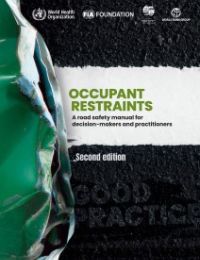
This manual provides guidance and evidence for decision-makers and practitioners that should lead to an increase in the use of vehicle occupant restraints, such as seat-belts for adults and car seats for babies and children. It draws on experience from countries that have succeeded in achieving and sustaining high levels of vehicle occupant restraint use, and builds on new evidence, including from low and middle-income countries.
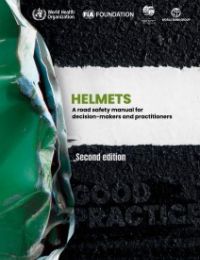
Safe, quality helmets reduce the risk of death in a road crash by over six times, and reduce the risk of brain injury by up to 74%. Head trauma is the leading cause of death for riders, and motorcycles continue to proliferate rapidly. Yet the use of helmets in many low and middle-income countries remains low.
The second edition of the Helmets Manual offers guidance to help decision makers and practitioners put in place the comprehensive set of laws, regulations and actions needed to increase the use of safe, quality helmets to save lives.
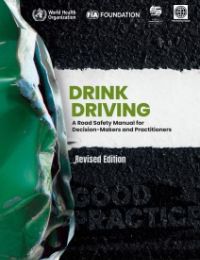
This manual provides guidance for decision-makers and practitioners to reduce the prevalence of drink driving and associated road trauma. It draws on experience from countries that have succeeded in achieving and sustaining reductions in alcohol-related road trauma, and includes recommendations for developing and implementing drink driving legislation, and advice on how to monitor and evaluate progress.
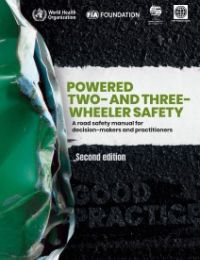
Nearly 30% of all road traffic deaths reported to WHO involve powered two- and three-wheeled vehicles, such as motorcycles, mopeds, scooters and electrical bikes (e-bikes). As these vehicles become increasingly widespread, particularly in low-and middle-income countries, the proportion of deaths involving them is increasing.
The second edition of the Powered- Two and Three-Wheeler Safety Manual offers guidance to help decision makers and practitioners put in place the comprehensive set of laws, regulations and actions needed to save lives. Rooted in new case studies and evidence, including from low- and middle-income countries, it includes guidelines on developing safer roads, ensuring safer mobility for all road users, vehicle safety standards, and actions to improve emergency responses to crashes.

Cycling has many health and environmental benefits. Yet every year 41 000 cyclists die in road traffic-related crashes worldwide. Many leave their homes as they would on any normal day – for school, work, worship, or meeting friends – never to return. Millions more people are injured in road traffic-related crashes while cycling, some of whom become permanently disabled. These incidents cause much suffering and grief, as well as economic hardship for families and loved ones.
However, the growing focus on sustainable mobility – an increasing effort to shift more travel from motorized transport to the use of public transport, walking and cycling – makes cyclists’ safety an increasingly important component of road safety efforts. Cyclist collisions, like other road traffic crashes, are predictable and preventable and therefore should not be accepted as inevitable.
Cyclist safety: an information resource for decision-makers and practitioners describes the magnitude of cyclist death and injury, the key risk factors, and effective interventions. The document stresses the importance of a comprehensive, holistic approach that includes legislation, enforcement and behavioral measures specifically for cyclists; design of the built environment; as well as integrating cyclist safety into overall road safety and transport strategies. It also draws attention to the benefits of cycling, which should be promoted as an important mode of transport given its potential to improve health and preserve the environment.
We hope that this resource, which is designed for a multidisciplinary audience including engineers, planners, law enforcement officers, public health professionals and educators, will contribute towards strengthening national and local capacity to implement cyclist safety measures in various settings worldwide. We encourage all to bring this resource to the attention of those who will use it to save the lives of cyclists.
The World Health Organization (WHO) coordinated the production of this resource. Soames Job, Head GRSF and Global Lead Road Safety, World Bank was one of the principal writers of this document. GRSF contributions to this document were supported by UK Aid.

The Road Safety Management Capacity Reviews and Safe System Projects Guidelines have been designed to assist country road safety professionals, World Bank and regional development bank staff, international consultants, community groups, private sector organizations, and all other global, regional and country partners and stakeholders to conduct capacity reviews and prepare follow-up road safety projects in a variety of low and middle-income countries and investment settings.
The purpose of the Guidelines is to:
The Guidelines emphasize managing for results and the associated strengthening of country road safety management systems, with special attention being paid to the role of the lead road safety agency in ensuring institutional effectiveness and efficiency in program delivery. They highlight the importance of addressing all elements of the road safety management system, taking a staged approach to country road safety investment, and targeting the highest concentrations of deaths and injuries across the road network.
For more information visit this page.
This report is also available in:

Las Directrices para los proyectos de sistemas seguros y las revisiones de la capacidad de gestión de la seguridad vial se han diseñado para ayudar a los profesionales de la seguridad vial de los países, al personal del Banco Mundial y de los bancos regionales de desarrollo, a los consultores internacionales, a los grupos comunitarios, a las organizaciones del sector privado y a todos los demás socios y partes interesadas mundiales, regionales y nacionales a realizar revisiones de la capacidad y preparar proyectos de seguimiento de la seguridad vial en una variedad de países de ingresos bajos y medios y entornos de inversión.
El propósito de las Directrices es:
Las Directrices hacen hincapié en la gestión para resultados y el fortalecimiento asociado de los sistemas de gestión de la seguridad vial de los países, prestando especial atención al papel del organismo líder de seguridad vial para garantizar la eficacia y eficiencia institucional en la ejecución del programa. Destacan la importancia de abordar todos los elementos del sistema de gestión de la seguridad vial, adoptar un enfoque por etapas para la inversión en seguridad vial del país y centrarse en las mayores concentraciones de muertes y lesiones en toda la red de carreteras.

Les Lignes directrices pour les examens des capacités de gestion de la sécurité routière et les projets de systèmes sûrs ont été conçues pour aider les professionnels de la sécurité routière des pays, le personnel de la Banque mondiale et des banques régionales de développement, les consultants internationaux, les groupes communautaires, les organisations du secteur privé et tous les autres partenaires et parties prenantes mondiaux, régionaux et nationaux à mener des examens des capacités et à préparer des projets de suivi de la sécurité routière dans divers pays à revenu faible et intermédiaire et contextes d'investissement.
L'objectif des Lignes directrices est de :
Les Lignes directrices mettent l'accent sur la gestion axée sur les résultats et le renforcement associé des systèmes de gestion de la sécurité routière des pays, une attention particulière étant accordée au rôle de l'agence principale de sécurité routière pour assurer l'efficacité et l'efficience institutionnelles dans l'exécution des programmes. Ils soulignent l’importance de prendre en compte tous les éléments du système de gestion de la sécurité routière, d’adopter une approche progressive en matière d’investissement dans la sécurité routière nationale et de cibler les concentrations les plus élevées de décès et de blessés sur l’ensemble du réseau routier.

